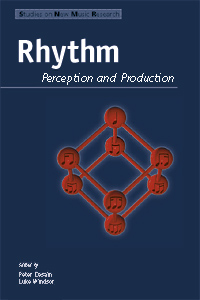

Book description with online soundexamples.
Desain, P. and L. Windsor (2000) Rhythm perception and production. Lisse: Swets and Zeitlinger.
This book is a primer for those interested in the perception and production of rhythm, giving readers both an overview of recent research in the introductions to each section and a broad selection of chapters dealing with more detailed studies. It consists of contributions by some of the most respected investigators in the fields of motor behavior, timing control, music cognition and psychology and arose out of the 7th Workshop on Rhythm Perception and Production held in Wassenaar in 1998.
The volume begins with a discussion of more generic studies of timing and synchronization, focusing on the two main methods of modeling timing behavior - the modern complex dynamics approach and the older methods of analysis of covariance - and some progress is made towards an integration of these two historically conflicting approaches. It then moves on to consider rhythm perception and production in a wide variety of contexts, with a particular focus on music and language. The individual contributions range from attempts to model the processes involved in tracking or synchronizing to an external pulse to detailed studies of the ways in which the rhythmic complexities of real musical and linguistic behavior (such as polyrhythmic drumming) are executed and perceived.
Contents
Introduction
Luke Windsor and Peter Desain.
Part I. Mental Timekeepers, Internal Clocks, Oscillators and Complex Dynamics
Introduction
Jeffrey Summers
Timekeepers versus nonlinear oscillators: How the approaches differPeter J. Beek, Lieke E. Peper and Andreas Daffertshofer
Considerations regarding a comprehensive model of (poly)rhythmic movement
Lieke E. Peper, Peter J. Beek and Andreas Daffertshofer
Limitations of the scanning procedure in assessing changes in coordination dynamics due to learning
Chris Jansen, Lieke Peper and Peter Beek
The learning and transfer of multifrequency patterns
Jeffrey J. Summers.
Part II. Tapping and Synchronization
Introduction
John A. Michon
On the nature of variability in isochronous serial interval productionGuy Madison
Synchronization error: an error in time perception ?
Andreas Wohlschläger and Robert Koch
Subliminal temporal discrimination revealed in closed-loop motor control
Bruno Repp
Tempo change: timing of simple temporal ratios
Marek Franûk, Ji_í Mates and Marika Nártová
Dynamics and embodiment in beat induction
Douglas Eck, Michael Gasser and Robert Port
Part III. Time Perception and Discrimination
Introduction
Bruno Repp
Demonstrations of time-shrinkingDaigoh Suetomi, Yoshitaka Nakajima, Takayuki Sasaki and Gert Ten Hoopen
Spatial attention deficits and the perception of interaural rhythmic sequences- a preliminary
Sophie K. Scott, Jason Mattingley, Tom Manly and Richard J.S. Wise
Information processing in the central executive: effects of concurrent temporal production and memory updating tasks
Scott W. Brown and C. Frieh Tigg
Part IV. Rhythm and Timing in Music and Speech
Introduction
Dirk Vorberg
Rhythmic aspects of vibratoPeter Desain, Henkjan Honing, Rinus Aarts, and Renee Timmers
On time: the influence of tempo structure and style on the timing of gracenotes in skilled musical performance
W. Luke Windsor, Rinus Aarts, Peter Desain, Hank Heijink and Renee Timmers
Complexity measures of musical rhythms
Ilya Shmulevich and Dirk-Jan Povel
Rhythm in music performance and perceived structure
Amandine Penel and Carolyn Drake
Why musicians tap slower than nonmusicians
Carolyn Drake, Amandine Penel and Emmanuel Bigand
Effects of delayed auditory feedback on speech, just a problem of displaced rhythm?
Katharina Müller, Gisa. Aschersleben, K.H. Esser and J.P.S. Muesseler
Preliminary investigations of French and English speech rhythm: are cross-linguistic differences in rhythmic organisation primarily metrical in origin?
Christopher S. Lee, Neil P. McAngus Todd, Geraldine A. Foster and Sevda Lomlu